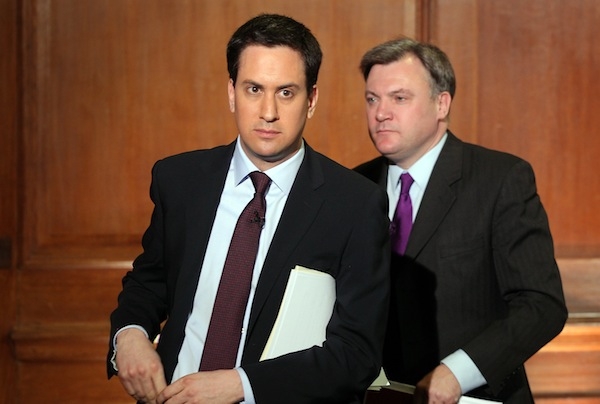Who’s on the side of the strivers? Is it George Osborne, who’s cutting benefits in real terms for the next three years, which he defends as ‘being fair to the person who leaves home every morning to go out to work and sees their neighbour still asleep, living a life on benefits’? Or is it Ed Balls, who’s opposing the move as Osborne ‘making striving working families pay the price for his economic failure’? Both men are convinced that their stance will help win the votes of low- and middle-income workers. At least one of them is wrong.
Isabel has explained the sources of Labour’s confidence. One is a YouGov poll released on Sunday, showing 42 per cent of ‘C2DEs’ (working class and lower) think benefits should rise at least in line with inflation. But then, 28 per cent of them think they should only rise by 1 per cent a year, and a further 15 per cent think they should be frozen altogether — a total of 43 per cent in favour of real-terms cuts. That’s not resounding support for Osborne’s policy, but it’s not a resounding rejection of it either. More convincing for Labour was an Ipsos MORI poll released yesterday, which (with a differently-worded question and different answer options) showed 69 per cent of the public and 73 per cent of C2DEs rejecting real-terms cuts.
But that Ipsos MORI poll also asked whether respondents felt that various groups ‘are being asked to do too much, too little, or about the right amount’ in response to the economic crisis. Just 28 per cent said ‘welfare claimants’ are suffering too much — including just 27 per cent of those C2DEs. Meanwhile, 34 per cent say they’re doing too little, including 32 per cent of C2DEs. But the most interesting responses are for the group ‘people like you’. Only 30 per cent say they’re being asked to do too much – 15 per cent say ‘too little’ and 52 per cent say ‘about the right amount’. Even the majority of C2DEs say they’re not shouldering too much of the burden.
Labour’s main hope, as Isabel reported, is that those who lose out financially will vote for them in 2015. But YouGov found that just 36 per cent think the measures in the Autumn Statement will make them worse off — 6 per cent say they’ll benefit, while 44 per cent say they won’t make much difference. And even among the C2DEs, slightly more think they’ll be better off (4 per cent) or about the same (40 per cent) than think they’ll lose out (40 per cent).
The point is that the polling on this is not clear-cut. Ipsos MORI’s ’69 per cent against benefit cuts’ figure is worrying for Osborne, but Labour don’t have much evidence for their claim that working benefit recipients will turn on the Tories over this. And besides, we’re only in the early days of a debate that will doubtless rage all the way to 2015. Even if Labour start out with more people backing their stance than the Tories (which the Ipsos MORI poll suggests they do, but the YouGov poll doesn’t), they’re going to have a difficult job keeping it that way as the battle unfolds. Having signed up to the government’s policy of increasing public sector pay by just 1 per cent a year, it’ll be tough for Eds Miliband and Balls to argue that benefits should rise faster. Even now, as they point to Resolution Foundation figures showing that the majority of the hit fall on working households, the riposte is obvious: why should the welfare component of their income rise faster than the work component?
By contrast, the coalition’s position seems more easily defensible. Essentially, they just need to produce this graph from the Institute for Fiscal Studies, showing that by the time of the next election — even with the 1 per cent a year rise — benefits will have gone up by about 21 per cent since 2009, whereas earnings will only have risen by 16 per cent.

It is interesting that both YouGov and Ipsos MORI both asked whether benefits should rise by more or less than inflation. One wonders how different the results would have been if they had asked whether they should rise more quickly or more slowly than wages. That’s certainly how George Osborne will be trying to frame the debate.






Comments